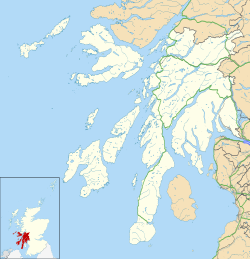Dervaig
| |
|---|---|
 The unusual round tower of the church | |
Location within Argyll and Bute | |
| OS grid reference | NM432518 |
| Community council | |
| Council area | |
| Lieutenancy area | |
| Country | Scotland |
| Sovereign state | United Kingdom |
| Post town | ISLE OF MULL |
| Postcode district | PA75 6 |
| Dialling code | 01688 |
| Police | Scotland |
| Fire | Scottish |
| Ambulance | Scottish |
| UK Parliament | |
| Scottish Parliament | |
Dervaig (Scottish Gaelic : Dearbhaig) is a small village on the Isle of Mull off the west coast of Scotland. [1] The village is within the parish of Kilninian and Kilmore, [1] and is situated on the B8073 [2] roughly midway between Tobermory and Calgary. In 1961 it had a population of 82. [1]


